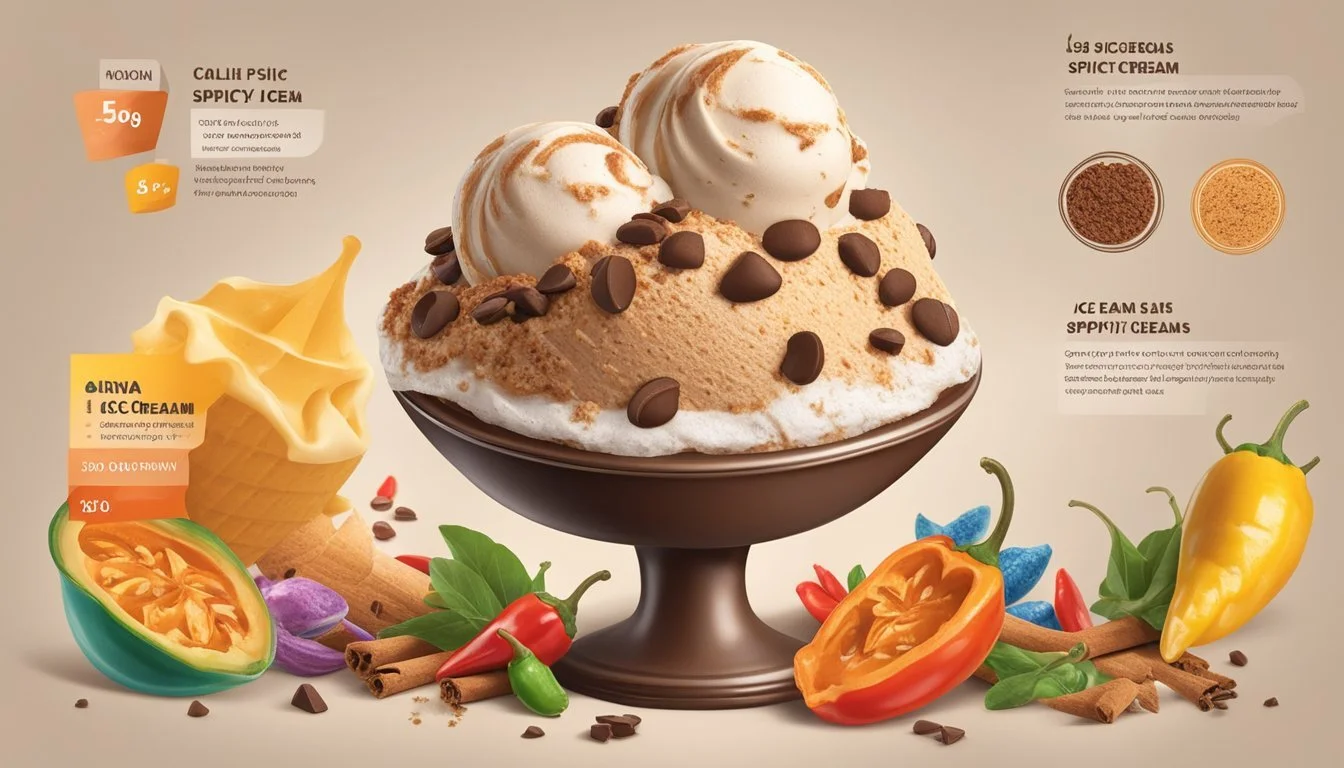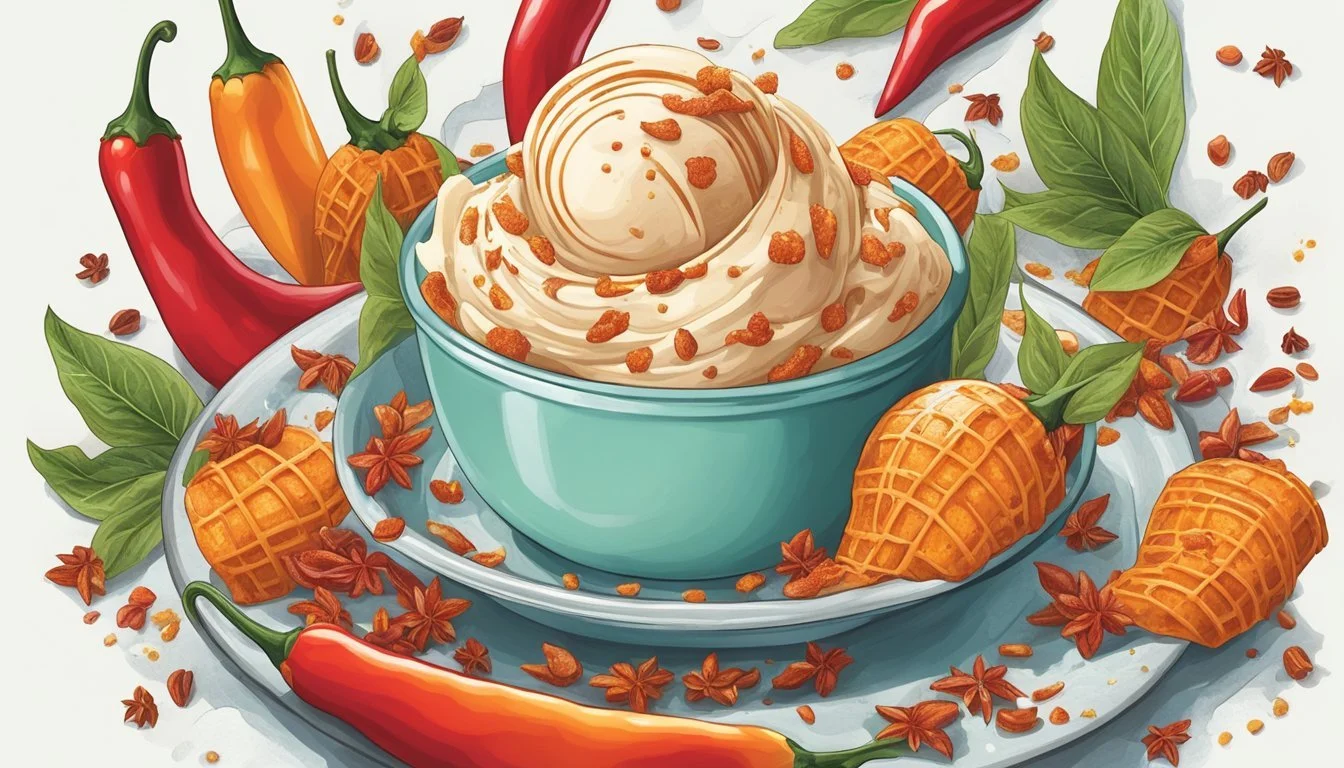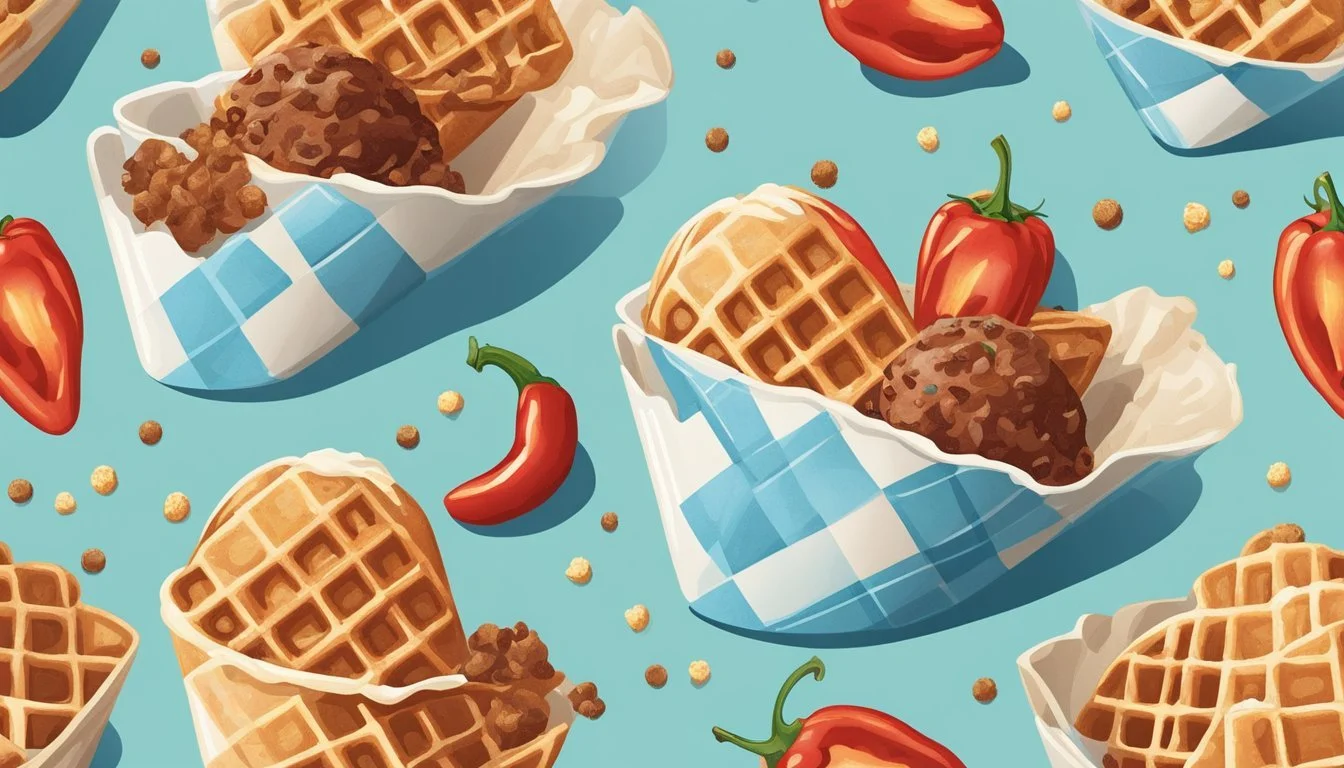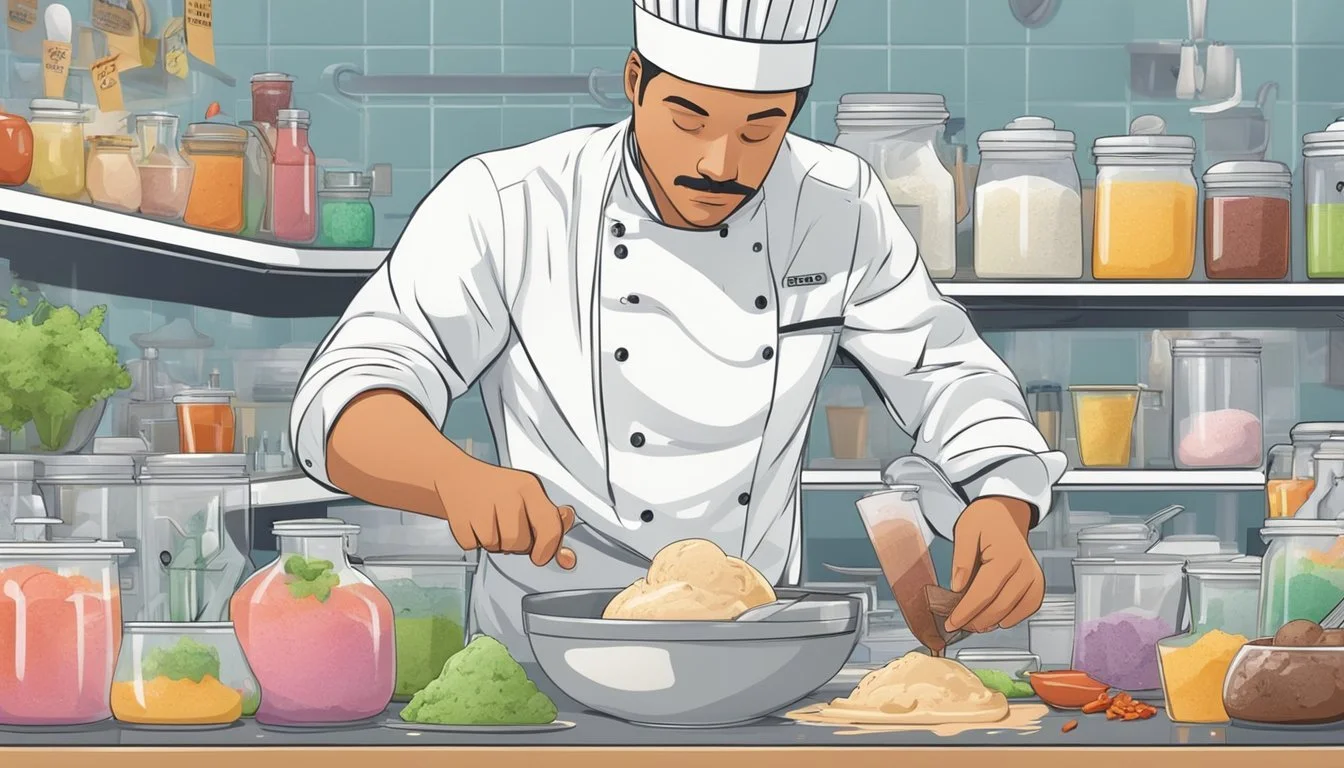Swicy Ice Creams
Unveiling the Secret to Spicy-Sweet Sensations
The fusion of contrasting flavors in the culinary world often leads to exciting and innovative creations. Spicy ice cream is one such trend, where the refreshing coolness of traditional ice cream is combined with unexpected kicks of heat, creating a delightfully surprising treat. Referred to as "swicy" by enthusiasts, this category of ice creams invites a unique sensory experience, piquing the interest of adventurous foodies. As new recipes appear across the globe, spicy ice cream is not only catching on as a novelty but also as a gourmet delicacy, proving that opposites do, in fact, attract.
While ice cream itself has been a staple dessert for centuries, the demand for new and unique flavors has ushered in an era of experimentation within the dessert domain. Spicy elements, such as chili, chipotle or even wasabi, are skillfully woven into creamy bases to create an appealing contrast that tantalizes the palate. The challenge for both home cooks and professional chefs alike is to balance the heat in such a way that it complements, rather than overwhelms, the sweet foundation of the ice cream.
In the making of "swicy" ice creams, recipe innovation is crucial, yet adherence to food safety and quality standards remains paramount. Ice cream manufacturers and recipe developers must ensure their new spicy offerings align with prevailing health codes and privacy policies related to consumer data, especially when engaging with clients through digital platforms. The spicy ice cream trend is a testament to the evolving tastes of consumers and the culinary sector's ability to cater to them with creativity and care.
The Rise of Spicy Ice Creams
In the landscape of frozen desserts (What wine goes well with desserts?), spicy ice cream has emerged as an innovative niche, bridging the gap between the fiery and the frosty. Consumers' quest for novel flavors and sensory experiences has fueled this trend.
A Brief History
Historically, ice cream has been a canvas for culinary creativity, long before the infusion of spicy elements. However, traditional flavors stood unopposed until gastronomic adventurers sought to enhance the basic sweet profile with contrasting flavors. Cookbooks over the years have played with the sweet and heat pairing, with some of the more daring ones even offering recipes for adventurous ice cream makers seeking the perfect scoop with a spicy twist.
Current Trends
Today, spicy ice cream is not just a fad but a testament to changing palates. The addition of spices like cayenne or jalapeño has transformed the simple ice cream experience into a complex delight. Hot honey, a condiment that marries sweetness with a kick of chili, has seen a significant rise in use, finding its way into ice cream flavors. Restaurant menus report a 38% increase in such sweet and spicy offerings, and the trend continues to grow. The concoction tantalizes taste buds and breaks the monotony of traditional flavors, earning its place as a must-try experience for culinary enthusiasts.
Understanding the Basics of Ice Cream
Before diving into the complexities of Swicy ice creams, it's essential to understand ice cream at its core—a frozen dessert beloved for its creamy texture and sweet taste.
Defining Ice Cream
Ice cream is a cold dessert made by churning and freezing a mixture primarily containing dairy and sugar. As they seek indulgence with a spicy twist, consumers must recognize that the essence of any ice cream, including those with unexpected flavor profiles, relies on the smooth and creamy structure that freezing and churning provide.
Traditional Ingredients
The foundational elements of ice cream recipes involve a balance of milk, sugar, and heavy cream. This trinity works in harmony to create ice cream's characteristic mouthfeel:
Milk: Provides the base liquid for ice cream, contributing to its overall flavor and nutritional content.
Sugar: Acts not only as a sweetener but also lowers the freezing point, which aids in achieving a softer consistency.
Heavy Cream: Infuses richness and lends to the creamy texture, with its higher fat content being crucial for the smooth quality of the dessert.
A custard base is also common in many recipes, created by cooking milk or cream with egg yolks, resulting in a thicker mixture that churns into a particularly smooth and indulgent ice cream.
In ice cream recipes, the ratio of these ingredients, the addition of salt to enhance flavor, and the careful balance between them are pivotal to the final product's texture and taste. After combining, this mixture usually undergoes a freezing process while being churned to prevent large ice crystals from forming, ensuring a consistently smooth and creamy frozen dessert. With the basics in place, creating Swicy ice creams with a spicy twist becomes an inventive exploration of flavor.
Crafting Your Spicy Ice Cream
Making spicy ice cream involves a keen understanding of flavor balance and preparation techniques to ensure a delightful fusion of heat and sweet. Carefully selected spices can transform a classic treat into an exhilarating experience.
Selecting Your Spices
One must choose spices that complement the base ingredients of the ice cream. Vanilla acts as a versatile backdrop that can be elevated with the warmth of cinnamon or the intensity of chili powder. For those desiring a fresh kick, jalapeños can lend a green, vegetal heat to the mix. It's essential to use spices that are finely ground to ensure even distribution throughout the ice cream.
Balancing Flavors
The secret to a successful spicy ice cream lies in the balance between the sweetness and the spiciness. The sugar content in the ice cream should counteract the heat without overpowering it. When crafting treats like chocolate chili ice cream or spicy chocolate ice cream, one must adjust the level of spiciness to work harmoniously with the rich bitterness of cocoa. Keep in mind that dairy can mellow spiciness, so consider the fat content of your base when determining the amount of spice to add.
Mild Spice: 1/2 teaspoon of chili powder per quart of base
Medium Spice: 3/4 teaspoon of chili powder per quart of base
Bold Spice: 1+ teaspoon of chili powder per quart of base
Preparation Techniques
The method of incorporating the spices is crucial. For chocolate-based ice creams, spices can be infused into the warm cream mixture during the initial stages of preparation. This ensures a thorough melding of flavors. When adding particulate spices such as cinnamon or chili powder, they must be sifted into the base to prevent clumping. With fresh ingredients like jalapeños, it's beneficial to introduce them early in the preparation phase, potentially steeping them in the cream to impart a distinct but not overpowering spice. After mixing, the base should be cooled promptly to prevent any unwanted flavor development.
The Science Behind Freezing
When crafting Swicy Ice Creams, understanding how temperatures affect the freezing process is essential. Precision in cooling techniques ensures the perfect balance between the icy texture and the bold, spicy flavors.
The Role of Temperatures
Temperature Control:
Critical Range: The ideal freezing temperature for homemade ice cream is between -20°C (-4°F) and -30°C (-22°F).
Consistency and Texture: Slow freezing forms large ice crystals, leading to a grainy texture, while quick freezing ensures a smooth, creamy consistency with small ice crystals.
Ingredients' Freezing Points:
Sugar and Spices: The addition of sugar and spices, a characteristic of Swicy Ice Creams, lowers the freezing point of the mixture, requiring the freezer to be set at a colder temperature to adequately solidify the ice cream.
Salt and Freezing: In commercial settings, salt is often used to lower the freezing point when making ice cream.
Freezer Tips
Best Practices for Freezing Homemade Ice Cream:
Pre-chill the mixture: Before freezing, it is beneficial to chill the Swicy Ice Cream mixture to 4°C (39°F) or below.
Airflow Matters: Freezers should not be overloaded, as this restricts airflow and affects the freezing process.
Container Selection:
Airtight Container: To prevent freezer burn and flavor contamination, store homemade ice cream in an airtight container.
Freezer-Safe Container: Always use a freezer-safe container to protect the quality of the ice cream.
By meticulously controlling temperatures and using the right containers, makers of Swicy Ice Cream can achieve the perfect synthesis of frosty delight and fiery zest.
Nutritional Information
In crafting spicy ice creams, one must consider the caloric impact as well as the potential for beneficial nutrients. This section looks closely at the nutritional profile of these unique desserts.
Caloric Breakdown
Spicy ice creams typically share a similar caloric range with traditional ice cream, considering their base ingredients. A single serving size, which is generally half a cup, can range from:
Calories: 150-250
Carbohydrates: 20-30 grams
Protein: 2-5 grams
Total Fat: 7-15 grams
Saturated Fat: 4-9 grams
Cholesterol: 20-40 milligrams
Sodium: 50-100 milligrams
These values can fluctuate based on specific ingredients such as the type of chocolate, the addition of nuts, and the inclusion of spice elements.
Beneficial Nutrients
While ice cream is often seen as an indulgence, spicy ice cream can offer some nutritional benefits:
Fiber: Ingredients like dark chocolate or chili powder may add fiber, essential for digestive health.
Potassium: Found in chocolate and dairy, aiding muscle and nerve function.
Vitamin A: Present in dairy, supporting vision and the immune system.
Vitamin C: Added spices such as chili powder can contribute to vitamin C intake.
Calcium: Integral for bone health and found in all dairy-based ice creams.
Iron: Chocolate is a good source of this essential mineral.
As with any dessert, it's recommended to enjoy spicy ice creams in moderation, as part of a balanced diet.
Advanced Ice Cream Making Techniques
Creating Swicy ice creams—combining the sweetness with a spicy kick—requires precision and mastery in ice cream making techniques. Here, we will explore the craft of creating these flavorful treats with state-of-the-art methods for both churn and no-churn approaches.
Using an Ice Cream Maker
Churned Ice Cream: The use of an ice cream maker is considered a traditional method in making creamy and homogeneously textured ice cream.
Preparation: The first step involves preparing a custard base using egg yolks, sugar, and cream. Vanilla extract is often added for a subtle flavor depth.
Churning: Once the base is cooled, it goes into the ice cream maker. Here, the base is churned steadily, which incorporates air and breaks up ice crystals as the mixture freezes.
Consistency: The process continues until the mixture reaches a soft-serve consistency. At this point, additional ingredients, such as spices for the 'Swicy' aspect, can be folded in before the mixture is moved to the freezer for further setting.
Equipment: Various types of ice cream makers are available:
Stand Mixer Attachment: For those with a stand mixer, an ice cream maker attachment can be a convenient option.
Electric Ice Cream Machine: Electric models often come with a built-in freezing mechanism, eliminating the need for pre-freezing bowls.
Hand-Cranked Ice Cream Maker: For a more hands-on approach, hand-cranked models offer a traditional ice cream making experience.
Non-Machine Methods
No-Churn Ice Cream: This method is ideal for those who do not own an ice cream machine but still seek a decadent, creamy texture.
Base Preparation: The base typically requires heavy cream whipped to form stiff peaks, condensed milk, and flavorings such as vanilla extract to ensure a rich taste.
Mixing: The spicy ingredients and any additional desired mix-ins are folded carefully into the base to avoid deflating the mixture.
Freezing: The final step involves transferring the mixture into a suitable container and freezing it until firm.
Tools Used in No-Churn Methods:
Blender: For smoothly integrating ingredients and ensuring even distribution of spice components.
Stand Mixer or Hand Mixer: To whip cream to the necessary consistency before folding in other elements.
Both churning with an ice cream maker and no-churn methods offer pathways to producing high-quality Swicy ice creams. Each technique has distinct steps and requires specific tools, but the end result is a premium homemade ice cream infused with the unique harmony of sweetness and heat.
Customizing Your Spicy Ice Cream
Crafting spicy ice cream involves a blend of creamy sweetness and a heat that tickles the palate. The adventure begins by selecting the right ingredients and ends with a visually appealing presentation that entices the senses.
Ingredient Variations
When one embarks on the journey of making spicy ice cream, they must consider the foundation of chocolate. A rich dark chocolate base offers a deep flavor that marries well with spice. For those with a preference for a slightly sweeter profile, semi-sweet chocolate or semi-sweet chocolate chips can be used.
The dairy component impacts the creaminess and texture of the ice cream. Whole milk adds a silky richness, while heavy cream elevates the ice cream to a luxurious level of indulgence. For a quick and easy spicy twist on a classic treat, one could start with pre-made vanilla ice cream or dark chocolate ice cream and mix in the desired spices.
Chocolate Base:
Dark chocolate is suited for a robust flavor.
Semi-sweet chocolate or chips offer a milder, sweeter base.
Dairy Choices:
Whole milk for richness.
Heavy cream for indulgence.
Pre-made Alternatives:
Vanilla or dark chocolate ice cream as a base for ease and convenience.
Garnishing and Presentation
The final aspect of crafting an unforgettable spicy ice cream is the presentation. Garnishes should not only complement the flavor but also add to the visual appeal. A dusting of cocoa powder or a drizzle of melted chocolate can be both aesthetically pleasing and flavor-enhancing. One might also consider adding a sprig of fresh mint or a few crushed nuts for texture contrast.
To present spicy ice cream, it is recommended to serve it in a clear bowl or glass to showcase the creamy consistency and the contrasting colors of the garnishes against the dark chocolate base.
Visual Garnishes:
Cocoa powder or melted chocolate for eye appeal.
Fresh mint or crushed nuts for added color and texture.
By focusing on ingredient variations and garnishing strategies, one can transform the traditional ice cream experience into a unique taste adventure with a spicy kick.
Preserving Your Ice Cream
Proper storage techniques are crucial for maintaining the texture and flavor of Swicy ice cream. The unique blend of spicy ingredients requires careful handling to ensure the treat remains enjoyable from the first scoop to the last.
Best Practices for Storage
To preserve Swicy Ice Cream:
Use Airtight Containers: Ice cream should be stored in freezer-safe, airtight containers to minimize exposure to air. This prevents freezer burn and flavor loss.
Material: Containers made from materials like Tupperware or silicone are preferred for their durability and seal quality.
Shape: Opt for containers with a shallow, flat shape to promote even freezing and ease of access.
Temperature: The freezer temperature should be set at 0°F (-18°C) or colder to ensure the ice cream remains solid and doesn't crystallize.
Location in Freezer: Store the ice cream away from the door, where temperature fluctuations are more common due to frequent opening.
By following these best practices, one can ensure that every scoop of Swicy Ice Cream is as delicious as intended, with the perfect creamy texture and bold spicy flavors.
Beyond the Spice: Additional Flavors and Textures
The innovative crafting of swicy ice creams introduces a palette of flavors and textures beyond the initial spicy surprise. These chilly treats pair carefully selected ingredients to elevate the sensory experience, with attention to how sugar tempers the heat and textural elements add a delightful contrast.
Innovative Combos
Swicy ice creams are not just about the thrill of heat; they're a calculated interplay between spicy and complementary flavors. For instance, the fiery kick of ghost pepper finds a soothing partner in mango, where the fruit's natural sweetness offsets the intensity. Here's a glance at some popular flavor pairings:
Cinnamon & Apple: A classic blend where the warmth of cinnamon enhances the fruit's tartness.
Blueberry & Jalapeño: Blueberries bring a sweet-tart profile that meshes with the subtle heat of jalapeños.
In these combinations, sugar acts as a mediator, not just as a sweetener but as a crucial ingredient that balances out the spiciness of the ice creams.
Texture Enhancements
Texture plays a pivotal role in crafting a memorable swicy ice cream. It's not merely about the smoothness of the ice cream; it's about the surprising crunch or chewiness that complements the creaminess. Consider these textural additions:
Ingredient Texture Contribution Chopped Nuts Crunchy Adds a satisfying crunch. Cookie Pieces Crumbly Offers a gentle resistance and chew. Candied Bacon Crisp & Chewy Provides a savory, crisp bite.
Strategically incorporating varied ingredients into swicy ice creams elevates them from simple desserts to complex creations that delight with every spoonful, engaging more senses and providing an unexpectedly harmonious eating experience.
Serving Suggestions
In the innovative world of desserts, Swicy ice cream balances the heat of spices with the coolness of sweet cream. The following serving suggestions are designed to enhance the unique experience of this flavor fusion.
Ideal Pairings
When serving Swicy ice cream, it's essential to consider how the heat contrasts with the cold and sweet treat. The adepts of Swicy flavors recommend:
Classic Companions: A simple slice of apple pie or a warm brownie can complement the ice cream's complexity, with the dessert's warmth intensifying the icy sensation.
Adventurous Combinations: For a bold taste adventure, pair Swicy ice cream with a citrus-based dessert, such as a lemon tart or key lime pie, to add a tangy twist.
Portion Control
Swicy ice cream, with its intense flavor profile, is typically enjoyed in smaller quantities compared to traditional flavors. Serving suggestions include:
Cups and Cones: Offer Swicy ice cream in small cups or cones, limiting the serving size to one scoop to ensure the balance of sweet and spicy notes without overwhelming the palate.
Tasting Events: If included in a dessert tasting menu, a portion size of two tablespoons allows guests to appreciate the flavor without diminishing their ability to enjoy subsequent desserts.
Community and Sharing
The fusion of chilly and spicy flavors in ice cream has created an innovative niche that enthusiasts are eager to explore and share. Communities, both online and offline, offer a space to exchange recipes, techniques, and experiences, fostering a sense of camaraderie among "Swicy" ice cream lovers.
Online Platforms
Online communities such as food blogs like Barefeet In The Kitchen provide a foundation for sharing inventive ice cream recipes that incorporate a spicy twist. These platforms encourage:
Recipe Exchange: Home cooks share their successful concoctions, often using detailed steps and visual aids.
Feedback Mechanism: Members give suggestions and modifications to help improve each other's recipes.
Readers and creators discuss the balance of sweet and heat in their creations, learning from one another’s successes and mistakes.
Ice Cream Socials
Offline, ice cream socials act as a tangible gathering space for aficionados of the spicy cold treat.
Tasting Events: These socials often feature a tasting session where attendees can sample a variety of homemade "Swicy" ice creams.
Community Building: Individuals bond over shared experiences, fostering connections and a sense of community.
Ice cream socials are pivotal in spreading the trend locally, creating a direct line of communication and feedback between creators and consumers.
Maintenance and Safety
In the creation of Swicy ice creams, which combine the chill of traditional frozen treats with the bold kick of spice, meticulous maintenance and strict adherence to safety protocols are paramount. Ensuring the cleanliness of equipment and meeting safety standards is essential to prevent contamination and to deliver a high-quality product.
Cleaning Your Equipment
It is crucial to start with thoroughly cleaned equipment. Ice cream makers should be disassembled as much as possible and every part that comes in contact with the product should be sanitized. This includes:
Dasher: The part that churns the ice cream mix should be scrubbed clean using a spatula to remove any residual mix, then rinsed with water, and finally sanitized with a solution.
Freezer Bowl: It must be free of any ice build-up or previous batch residue. A gentle cleaning with warm water and a mild detergent, followed by a rinse and a kosher salt scrub can help to maintain its optimal condition.
Adhering to Safety Standards
Following safety standards is essential in the Swicy ice cream making process to prevent foodborne illnesses. Considerations include:
Temperature Control: One must ensure that the ice cream is stored and served at -18°C to -12°C to prevent bacterial growth.
ServSafe Guidelines: Adherence to a recognized food safety program like ServSafe ensures that individuals are trained to handle and serve ice cream safely.












